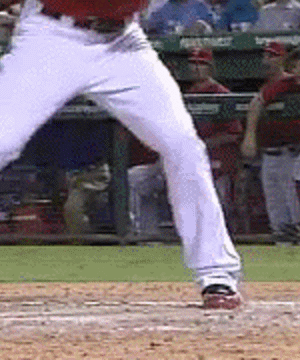FiveFrameSwing
Banned
Personally, I see the rear knee moving ....



Personally, I see the rear knee moving ....



I see the rear knee moving also. Every coach, parent and instructor that I know sees the rear knee moving. Which is why kids are commonly taught to turn the back knee down-and-in. That's the movement that everyone sees so that's the movement that gets taught.
Here is the movement that few see:

You have pressure being created by the muscles in the pelvis. You have the back foot holding onto or catching that pressure. The back knee is simply caught in the middle of these two pressure points. The back knee action is a result of what is going on between the pelvis and back foot.
It's important to understand that the muscles of the body create force. The force creates movement. The forces are reacting between the ground and pelvis. IMO, the above clip is a good example that proves that pro hitters are not trying to internally rotate the back leg. When you just internally rotate the leg, the heel pops up immediately and the pressure at the back foot is gone. The result is spin. The reason the back foot stays down so long is because the pressure created by the external rotator muscles in the pelvis (your butt muscles) is being retained at the back foot.
I see the rear knee moving also. Every coach, parent and instructor that I know sees the rear knee moving. Which is why kids are commonly taught to turn the back knee down-and-in. That's the movement that everyone sees so that's the movement that gets taught.
Here is the movement that few see:

You have pressure being created by the muscles in the pelvis. You have the back foot holding onto or catching that pressure. The back knee is simply caught in the middle of these two pressure points. The back knee action is a result of what is going on between the pelvis and back foot.
It's important to understand that the muscles of the body create force. The force creates movement. The forces are reacting between the ground and pelvis. IMO, the above clip is a good example that proves that pro hitters are not trying to internally rotate the back leg. When you just internally rotate the leg, the heel pops up immediately and the pressure at the back foot is gone. The result is spin. The reason the back foot stays down so long is because the pressure created by the external rotator muscles in the pelvis (your butt muscles) is being retained at the back foot.
